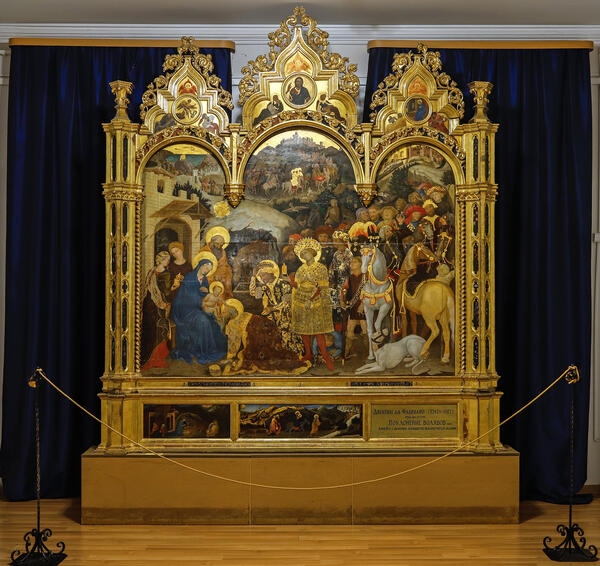The original painting “Adoration of the Magi” is housed in the Uffizi Gallery in Florence. It is larger than the copy (300×282 cm) and uses a special 15th-century method of painting with tempera instead of oil. It was created by the Italian painter Gentile da Fabriano. The copy was produced by an unknown artist in the 19th century. It was made with great care and attention to every detail of the complex altarpiece.
In 1423, the wealthy Italian banker and politician Palla Strozzi decided to give a valuable gift to his hometown, Florence. He hired the jeweler and sculptor Lorenzo Ghiberti to decorate the interior of Santa Trinita (Holy Trinity Church) and commissioned the painter Gentile da Fabriano to paint the altarpiece.
Gentile da Fabriano painted in the International Gothic style that was characterized by an impressive grandeur, magnificence, and luxury. The Adoration of the Magi was a popular subject in 15th-century painting because it allowed the customer to demonstrate their wealth and cultural competence, and the artist to show their craftsmanship and power of imagination.
The altarpiece depicts several Nativity scenes from the Gospel in a manner typical of the Middle Ages and the Renaissance. The upper part of a frame is a triptych with three half-moon-shaped areas known as lunettes. Contrary to the tradition of combining several subjects, Gentile used the entire surface to depict one scene. He used this technique to reflect the continuity of the journey of the Magi.
The central panel portrays the Adoration of the Magi. According to the story, the Magi came from faraway lands in the East to lay their gifts before the Child Jesus. In just one scene, Gentile brought together a diverse mix of detail and characters, including exotic animals, people of various races, and even the commissioner Palla Strozzi himself holding a falcon. All of this serves to excite curiosity in the viewer and to offer a revised interpretation of the Bible story.
The item from the Voronezh Art Museum features the following inscription: “An 18th-century copy made from the original housed by the Florence Academy”. However, according to expert reports, the copy was created in the early 19th century.
In 1423, the wealthy Italian banker and politician Palla Strozzi decided to give a valuable gift to his hometown, Florence. He hired the jeweler and sculptor Lorenzo Ghiberti to decorate the interior of Santa Trinita (Holy Trinity Church) and commissioned the painter Gentile da Fabriano to paint the altarpiece.
Gentile da Fabriano painted in the International Gothic style that was characterized by an impressive grandeur, magnificence, and luxury. The Adoration of the Magi was a popular subject in 15th-century painting because it allowed the customer to demonstrate their wealth and cultural competence, and the artist to show their craftsmanship and power of imagination.
The altarpiece depicts several Nativity scenes from the Gospel in a manner typical of the Middle Ages and the Renaissance. The upper part of a frame is a triptych with three half-moon-shaped areas known as lunettes. Contrary to the tradition of combining several subjects, Gentile used the entire surface to depict one scene. He used this technique to reflect the continuity of the journey of the Magi.
The central panel portrays the Adoration of the Magi. According to the story, the Magi came from faraway lands in the East to lay their gifts before the Child Jesus. In just one scene, Gentile brought together a diverse mix of detail and characters, including exotic animals, people of various races, and even the commissioner Palla Strozzi himself holding a falcon. All of this serves to excite curiosity in the viewer and to offer a revised interpretation of the Bible story.
The item from the Voronezh Art Museum features the following inscription: “An 18th-century copy made from the original housed by the Florence Academy”. However, according to expert reports, the copy was created in the early 19th century.



